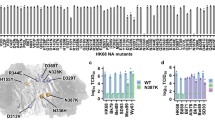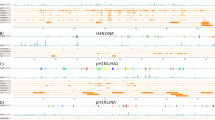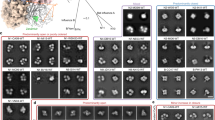Abstract
Influenza neuraminidase (NA) is a sialidase that contributes to viral mobility by removing the extracellular receptors for the haemagglutinin (HA) glycoprotein. However, it remains unclear why influenza NAs evolved to function as Ca2+-dependent tetramers that display variable stability. Here, we show that the Ca2+ ion located at the centre of the NA tetramer is a major stability determinant, as this Ca2+ ion is required for catalysis and its binding affinity varies between NAs. By examining NAs from 2009 pandemic-like H1N1 viruses, we traced the affinity variation to local substitutions that cause residues in the central Ca2+-binding pocket to reposition. A temporal analysis revealed that these local substitutions predictably alter the stability of the 2009 pandemic-like NAs and contribute to the tendency for the stability to vary up and down over time. In addition to the changes in stability, the structural plasticity of NA was also shown to support the formation of heterotetramers, which creates a mechanism for NA to obtain hybrid properties and propagate suboptimal mutants. Together, these results demonstrate how the structural restrictions for activity provide influenza NA with several mechanisms for adaptation and diversification.
This is a preview of subscription content, access via your institution
Access options
Access Nature and 54 other Nature Portfolio journals
Get Nature+, our best-value online-access subscription
$29.99 / 30 days
cancel any time
Subscribe to this journal
Receive 12 digital issues and online access to articles
$119.00 per year
only $9.92 per issue
Buy this article
- Purchase on Springer Link
- Instant access to full article PDF
Prices may be subject to local taxes which are calculated during checkout







Similar content being viewed by others
Data availability
All of the raw data for the figures presented in this study are available in the Supplementary Information.
Change history
16 June 2020
An amendment to this paper has been published and can be accessed via a link at the top of the paper.
References
Harris, A. et al. Influenza virus pleiomorphy characterized by cryoelectron tomography. Proc. Natl Acad. Sci. USA 103, 19123–19127 (2006).
Dou, D., Revol, R., Östbye, H., Wang, H. & Daniels, R. Influenza A virus cell entry, replication, virion assembly and movement. Front. Immunol. 9, 1581 (2018).
Weis, W. et al. Structure of the influenza virus haemagglutinin complexed with its receptor, sialic acid. Nature 333, 426–431 (1988).
Hamilton, B. S., Whittaker, G. R. & Daniel, S. Influenza virus-mediated membrane fusion: determinants of hemagglutinin fusogenic activity and experimental approaches for assessing virus fusion. Viruses 4, 1144–1168 (2012).
Burnet, F. M. Mucins and mucoids in relation to influenza virus action; inhibition of virus haemagglutination by glandular mucins. Aust. J. Exp. Biol. Med. Sci. 26, 371–380 (1948).
Matrosovich, M. N., Matrosovich, T. Y., Gray, T., Roberts, N. A. & Klenk, H. D. Neuraminidase is important for the initiation of influenza virus infection in human airway epithelium. J. Virol. 78, 12665–12667 (2004).
Cohen, M. et al. Influenza A penetrates host mucus by cleaving sialic acids with neuraminidase. Virol. J. 10, 321 (2013).
Yang, X. et al. A beneficiary role for neuraminidase in influenza virus penetration through the respiratory mucus. PLoS ONE 9, e110026 (2014).
Burnet, F. M., Mc, C. J. & Anderson, S. G. Mucin as substrate of enzyme action by viruses of the mumps influenza group. Nature 160, 404–405 (1947).
Burnet, F. M. Mucins and mucoids in relation to influenza virus action; the destruction of Francis inhibitor activity in a purified mucoid by virus action. Aust. J. Exp. Biol. Med. Sci. 26, 389–402 (1948).
Gottschalk, A. Neuraminidase: the specific enzyme of influenza virus and vibrio cholerae. Biochim. Biophys. Acta 23, 645–646 (1957).
Sakai, T., Nishimura, S. I., Naito, T. & Saito, M. Influenza A virus hemagglutinin and neuraminidase act as novel motile machinery. Sci. Rep. 7, 45043 (2017).
Webster, R. G. & Laver, W. G. Preparation and properties of antibody directed specifically against the neuraminidase of influenza virus. J. Immunol. 99, 49–55 (1967).
Seto, J. T. & Rott, R. Functional significance of sialidose during influenza virus multiplication. Virology 30, 731–737 (1966).
Kilbourne, E. D., Laver, W. G., Schulman, J. L. & Webster, R. G. Antiviral activity of antiserum specific for an influenza virus neuraminidase. J. Virol. 2, 281–288 (1968).
Compans, R. W., Dimmock, N. J. & Meier-Ewert, H. Effect of antibody to neuraminidase on the maturation and hemagglutinating activity of an influenza A2 virus. J. Virol. 4, 528–534 (1969).
Palese, P. & Compans, R. W. Inhibition of influenza virus replication in tissue culture by 2-deoxy-2,3-dehydro-N-trifluoroacetylneuraminic acid (FANA): mechanism of action. J. Gen. Virol. 33, 159–163 (1976).
Mitnaul, L. J. et al. Balanced hemagglutinin and neuraminidase activities are critical for efficient replication of influenza A virus. J. Virol. 74, 6015–6020 (2000).
Xu, R. et al. Functional balance of the hemagglutinin and neuraminidase activities accompanies the emergence of the 2009 H1N1 influenza pandemic. J. Virol. 86, 9221–9232 (2012).
Varghese, J. N., Laver, W. G. & Colman, P. M. Structure of the influenza virus glycoprotein antigen neuraminidase at 2.9 Å resolution. Nature 303, 35–40 (1983).
Dou, D., da Silva, D. V., Nordholm, J., Wang, H. & Daniels, R. Type II transmembrane domain hydrophobicity dictates the cotranslational dependence for inversion. Mol. Biol. Cell 25, 3363–3374 (2014).
Nordholm, J. et al. Translational regulation of viral secretory proteins by the 5′ coding regions and a viral RNA-binding protein. J. Cell Biol. 216, 2283–2293 (2017).
Wang, N., Glidden, E. J., Murphy, S. R., Pearse, B. R. & Hebert, D. N. The cotranslational maturation program for the type II membrane glycoprotein influenza neuraminidase. J. Biol. Chem. 283, 33826–33837 (2008).
da Silva, D. V., Nordholm, J., Madjo, U., Pfeiffer, A. & Daniels, R. Assembly of subtype 1 influenza neuraminidase is driven by both the transmembrane and head domains. J. Biol. Chem. 288, 644–653 (2013).
Nordholm, J., da Silva, D. V., Damjanovic, J., Dou, D. & Daniels, R. Polar residues and their positional context dictate the transmembrane domain interactions of influenza a neuraminidases. J. Biol. Chem. 288, 10652–10660 (2013).
da Silva, D. V. et al. The influenza virus neuraminidase protein transmembrane and head domains have coevolved. J. Virol. 89, 1094–1104 (2015).
Air, G. M. Influenza neuraminidase. Influenza Other Respir. Virus. 6, 245–256 (2012).
Li, Q. et al. The 2009 pandemic H1N1 neuraminidase N1 lacks the 150-cavity in its active site. Nat. Struct. Mol. Biol. 17, 1266–1268 (2010).
Xu, X., Zhu, X., Dwek, R. A., Stevens, J. & Wilson, I. A. Structural characterization of the 1918 influenza virus H1N1 neuraminidase. J. Virol. 82, 10493–10501 (2008).
Colman, P. M., Varghese, J. N. & Laver, W. G. Structure of the catalytic and antigenic sites in influenza virus neuraminidase. Nature 303, 41–44 (1983).
Crennell, S. J., Garman, E. F., Laver, W. G., Vimr, E. R. & Taylor, G. L. Crystal structure of a bacterial sialidase (from Salmonella typhimurium LT2) shows the same fold as an influenza virus neuraminidase. Proc. Natl Acad. Sci. USA 90, 9852–9856 (1993).
Taylor, G. Sialidases: structures, biological significance and therapeutic potential. Curr. Opin. Struct. Biol. 6, 830–837 (1996).
Paterson, R. G. & Lamb, R. A. Conversion of a class II integral membrane protein into a soluble and efficiently secreted protein: multiple intracellular and extracellular oligomeric and conformational forms. J. Cell Biol. 110, 999–1011 (1990).
Carroll, S. M. & Paulson, J. C. Complete metal ion requirement of influenza virus N1 neuraminidases. Arch. Virol. 71, 273–277 (1982).
Burmeister, W. P., Cusack, S. & Ruigrok, R. W. Calcium is needed for the thermostability of influenza B virus neuraminidase. J. Gen. Virol. 75, 381–388 (1994).
Sultana, I. et al. Stability of neuraminidase in inactivated influenza vaccines. Vaccine 32, 2225–2230 (2014).
Francis, T. Dissociation of hemagglutinating and antibody-measuring capacities of influenza virus. J. Exp. Med. 85, 1–7 (1947).
Baker, N. J. & Gandhi, S. S. Effect of Ca++ on the stability of influenza virus neuraminidase. Arch. Virol. 52, 7–18 (1976).
Briody, D. A. Characterization of the enzymic action of influenza viruses on human red cells. J. Immunol. 59, 115–127 (1948).
Dimmock, N. J. Dependence of the activity of an influenza virus neuraminidase upon Ca2+. J. Gen. Virol. 13, 481–483 (1971).
Chong, A. K., Pegg, M. S. & von Itzstein, M. Influenza virus sialidase: effect of calcium on steady-state kinetic parameters. Biochim. Biophys. Acta 1077, 65–71 (1991).
Zanin, M. et al. An amino acid in the stalk domain of N1 neuraminidase is critical for enzymatic activity. J. Virol. 91, e00868-16 (2017).
Dai, M. et al. Identification of residues that affect oligomerization and/or enzymatic activity of influenza virus H5N1 neuraminidase proteins. J. Virol. 90, 9457–9470 (2016).
Mok, C. K. et al. Evolutionarily conserved residues at an oligomerization interface of the influenza A virus neuraminidase are essential for viral survival. Virology 447, 32–44 (2013).
Takahashi, T., Song, J., Suzuki, T. & Kawaoka, Y. Mutations in NA that induced low pH-stability and enhanced the replication of pandemic (H1N1) 2009 influenza a virus at an early stage of the pandemic. PLoS ONE 8, e64439 (2013).
Labadie, T., Batejat, C., Manuguerra, J. C. & Leclercq, I. Influenza virus segment composition influences viral stability in the environment. Front. Microbiol. 9, 1496 (2018).
Collins, P. J. et al. Crystal structures of oseltamivir-resistant influenza virus neuraminidase mutants. Nature 453, 1258–1261 (2008).
Xue, K. S., Hooper, K. A., Ollodart, A. R., Dingens, A. S. & Bloom, J. D. Cooperation between distinct viral variants promotes growth of H3N2 influenza in cell culture. eLife 5, e13974 (2016).
Talley, K. & Alexov, E. On the pH-optimum of activity and stability of proteins. Proteins 78, 2699–2706 (2010).
van der Vries, E. et al. H1N1 2009 pandemic influenza virus: resistance of the I223R neuraminidase mutant explained by kinetic and structural analysis. PLoS Pathog. 8, e1002914 (2012).
Dou, D. et al. Analysis of IAV replication and co-infection dynamics by a versatile RNA viral genome labeling method. Cell Rep. 20, 251–263 (2017).
van der Vries, E. et al. Multidrug resistant 2009 A/H1N1 influenza clinical isolate with a neuraminidase I223R mutation retains its virulence and transmissibility in ferrets. PLoS Pathog. 7, e1002276 (2011).
Burmeister, W. P., Ruigrok, R. W. & Cusack, S. The 2.2 A resolution crystal structure of influenza B neuraminidase and its complex with sialic acid. EMBO J. 11, 49–56 (1992).
Schmidt, P. M., Attwood, R. M., Mohr, P. G., Barrett, S. A. & McKimm-Breschkin, J. L. A generic system for the expression and purification of soluble and stable influenza neuraminidase. PLoS ONE 6, e16284 (2011).
Eichelberger, M. C. & Wan, H. Influenza neuraminidase as a vaccine antigen. Curr. Top. Microbiol. Immunol. 386, 275–299 (2015).
Gao, J. et al. Antigenic drift of the influenza A(H1N1)pdm09 virus neuraminidase results in reduced effectiveness of A/California/7/2009 (H1N1pdm09)-specific antibodies. mBio 10, e00307-19 (2019).
Chen, Y. Q. et al. Influenza infection in humans induces broadly cross-reactive and protective neuraminidase-reactive antibodies. Cell 173, 417–429 (2018).
Johansson, B. E. & Kilbourne, E. D. Dissociation of influenza virus hemagglutinin and neuraminidase eliminates their intravirionic antigenic competition. J. Virol. 67, 5721–5723 (1993).
Johansson, B. E., Matthews, J. T. & Kilbourne, E. D. Supplementation of conventional influenza A vaccine with purified viral neuraminidase results in a balanced and broadened immune response. Vaccine 16, 1009–1015 (1998).
Hoffmann, E., Neumann, G., Kawaoka, Y., Hobom, G. & Webster, R. G. A DNA transfection system for generation of influenza A virus from eight plasmids. Proc. Natl Acad. Sci. USA 97, 6108–6113 (2000).
Mellroth, P. et al. LytA, major autolysin of Streptococcus pneumoniae, requires access to nascent peptidoglycan. J. Biol. Chem. 287, 11018–11029 (2012).
Harbury, P. B., Zhang, T., Kim, P. S. & Alber, T. A switch between two-, three-, and four-stranded coiled coils in GCN4 leucine zipper mutants. Science 262, 1401–1407 (1993).
Chutinimitkul, S. et al. Virulence-associated substitution D222G in the hemagglutinin of 2009 pandemic influenza A(H1N1) virus affects receptor binding. J. Virol. 84, 11802–11813 (2010).
Reed, L. J. & Muench, H. A simple method of estimating fifty per cent end points. Am. J. Epidemiol. 27, 493–497 (1938).
Kawakami, E. et al. Strand-specific real-time RT-PCR for distinguishing influenza vRNA, cRNA, and mRNA. J. Virol. Methods 173, 1–6 (2011).
Huang, Y., Niu, B., Gao, Y., Fu, L. & Li, W. CD-HIT Suite: a web server for clustering and comparing biological sequences. Bioinformatics 26, 680–682 (2010).
Waterhouse, A. M., Procter, J. B., Martin, D. M., Clamp, M. & Barton, G. J. Jalview Version 2—a multiple sequence alignment editor and analysis workbench. Bioinformatics 25, 1189–1191 (2009).
Zhu, X. et al. Influenza virus neuraminidases with reduced enzymatic activity that avidly bind sialic acid receptors. J. Virol. 86, 13371–13383 (2012).
Acknowledgements
We thank R. Fouchier (Erasmus Medical Center) and A. Pfeiffer for reading the manuscript and offering several suggestions, M. Oliveberg (Stockholm University), P. Ädelroth (Stockholm University) and J. Nordholm for discussions, and B. Fu for help generating PyMOL images. This work was supported in part by grants from the Swedish Research Council (K2015-57-21980-04-4) and the Carl Trygger Foundation (CTS17:111), as well as federal funds from the NIAID, National Institutes of Health, Department of Health and Human Services, under CEIRS contract number HHSN272201400005C.
Author information
Authors and Affiliations
Contributions
H.W. designed and performed the majority of the experiments and analysed most of the data. D.D. designed and performed most of the viral growth experiments under Ca2+-depletion conditions, some of the NA thermostability experiments and contributed to the statistical analysis. H.Ö. performed most of the NA temporal stability experiments, the bioinformatic analysis for the amino acid frequency at position 106 in NA and most of the co-transfection experiments. R.R. performed the amino acid conservation mapping for N1 and N2. R.D. conceived and supervised the study and wrote the manuscript with help from H.W.
Corresponding author
Ethics declarations
Competing interests
The authors declare no competing interests.
Additional information
Publisher’s note: Springer Nature remains neutral with regard to jurisdictional claims in published maps and institutional affiliations.
Supplementary information
Supplementary Information
Supplementary Figs. 1–28, Supplementary Tables 1–5 and Supplementary Data.
Supplementary Data 1
Excel file containing the raw NA activity measurements and normalizations.
Rights and permissions
About this article
Cite this article
Wang, H., Dou, D., Östbye, H. et al. Structural restrictions for influenza neuraminidase activity promote adaptation and diversification. Nat Microbiol 4, 2565–2577 (2019). https://doi.org/10.1038/s41564-019-0537-z
Received:
Accepted:
Published:
Issue Date:
DOI: https://doi.org/10.1038/s41564-019-0537-z
This article is cited by
-
Structure-based design of stabilized recombinant influenza neuraminidase tetramers
Nature Communications (2022)
-
Antigenic comparison of the neuraminidases from recent influenza A vaccine viruses and 2019–2020 circulating strains
npj Vaccines (2022)



